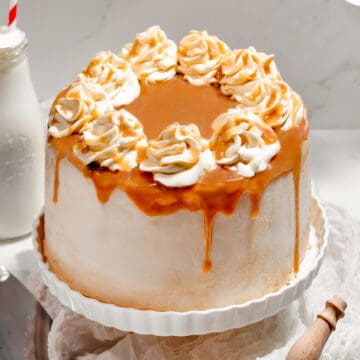
Butterscotch Cake
This butterscotch cake features an incredibly soft, fluffy sponge cake covered in a light, creamy butterscotch Swiss meringue frosting, and drizzled with homemade butterscotch sauce.
Print
Pin
Servings: 12 servings
Equipment
- electric or stand mixer
Ingredients
Butterscotch Cake:
- 3 cups all-purpose flour
- 1 teaspoon baking powder
- 1 teaspoon salt
- 1 cup unsalted butter, melted
- 1 and ½ cups brown sugar, packed
- 4 large egg yolks
- 1 and ¼ cups whole milk
- 4 large egg whites, room temperature
- ¼ teaspoon cream of tartar
- ½ cup granulated sugar, sifted
Butterscotch Sauce:
- ¼ cup unsalted butter
- ½ cup brown sugar, packed
- 1 tablespoon corn syrup
- ¼ teaspoon salt
- 2 tablespoons heavy cream
Butterscotch Swiss Meringue Buttercream:
- 4 large egg whites
- ¼ teaspoon cream of tartar
- 1 cup brown sugar, packed
- ½ teaspoon salt
- 1 cup unsalted butter, softened to 65°F and cut into small pieces
Instructions
Butterscotch Sponge Cake:
- Preheat your oven to 350°F. Lightly spray the inside of three (8-inch) round cake pans with non-stick spray and line the bottoms with parchment paper.
- Separate the eggs while cold and set the egg whites aside to come to room temperature. Make sure you don't get any yolk in the bowl with the egg whites.
- In a medium bowl, whisk the flour, baking powder, and salt. Set aside.
- In a large bowl, whisk the melted butter, brown sugar, and egg yolks until well combined. Mix in the dry ingredients, then mix in the whole milk.
- Make the meringue: Add the egg whites and cream of tartar to a large, clean bowl or bowl of a stand mixer. Use an electric mixer or the whisk attachment in the stand mixer to whip the egg whites until starting to thicken.
- Add the sifted granulated sugar, about 1 tablespoon at a time, and mix for 20 seconds after each addition. Once all of the sugar is added, mix until thick and fluffy with stiff peaks.
- Fold the cake batter: In 2-3 additions, use a spatula to gently fold the meringue into the cake batter by wiping around the sides and bottom of the bowl. Fold until just combined.
- Bake: Divide the cake batter evenly between the three prepared cake pans. Bake in the preheated oven for 30-35 minutes. You should be able to gently press the tops of the cakes and a toothpick should come out clean.
- Remove from the oven and let cool completely in the pans before removing. Then, cool completely in the fridge or freezer before frosting and assembling the cake.
Homemade Butterscotch Sauce:
- Add the butter, brown sugar, corn syrup, and salt to a medium saucepan. Cook and stir until the sugar is melted.
- Stir in the heavy cream. Remove from heat and transfer the sauce to a bowl to cool.
Butterscotch Swiss Meringue Buttercream:
- Add the egg whites, cream of tartar, brown sugar, and salt to a large bowl or bowl of a stand mixer.
- Place the bowl over a pot of barely simmering water. Make sure the bottom of the bowl isn't touching the water or the egg whites will start to cook.
- Whisk the egg white mixture until the sugar is dissolved and the temperature reaches 145°F on a digital thermometer.*
- Remove the bowl from the simmering water. Use an electric mixer or the whisk attachment in your stand mixer to whip the egg whites to stiff peaks.
- Switch to the paddle attachment in your stand mixer if using. Add the softened butter, one small piece at a time, and mix until fully incorporated, or about 20 seconds, after each addition. The meringue will deflate at first, then thicken up and become fluffy once all of the butter is added.
Assemble the Cake:
- Place one cake layer on a cake board or a serving plate. Use a piping bag or an offset spatula to add a layer of buttercream on top of the cake, then drizzle some butterscotch sauce over the frosting.If the sauce is too thick, gently warm it up in the microwave until it's a pourable consistency, but not too hot or it will melt the frosting.
- Set a second cake layer on top and add more frosting and butterscotch sauce. Repeat with the third cake layer.
- Add a thin layer of frosting around the sides of the cake. Drizzle more butterscotch sauce over the top of the cake, allowing some to drip down the sides, if desired.
Notes
Cover and store the cake at room temperature for 2-3 days, or in the fridge for 1 week.
* If you don't have a thermometer, check by rubbing some of the mixture between your fingers. It should be warm and you shouldn't feel any granules of sugar.
How to fix a broken/grainy buttercream: This happens when the butter is not soft enough when it's added. To fix it, place the bowl of frosting over a pot of gently simmering water for a few minutes until it smooths out. Then whip it up again until thick and fluffy.
How to fix a soupy buttercream: This happens if the butter is too warm when it's added. To fix it, place the bowl of frosting in the fridge for about 15 minutes. Then re-whip until thick and fluffy.
Nutrition
Serving: 1serving | Calories: 729kcal | Carbohydrates: 91g | Protein: 8g | Fat: 39g | Saturated Fat: 24g | Polyunsaturated Fat: 2g | Monounsaturated Fat: 10g | Trans Fat: 1g | Cholesterol: 160mg | Sodium: 446mg | Potassium: 223mg | Fiber: 1g | Sugar: 66g | Vitamin A: 1239IU | Vitamin C: 0.01mg | Calcium: 124mg | Iron: 2mg